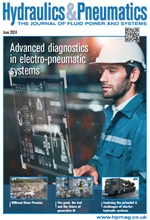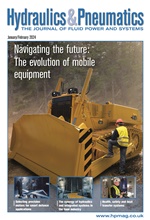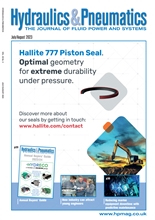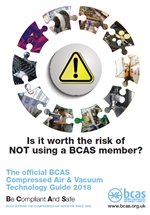The first step towards compressed air efficiency takes just 10 minutes

One barrier to energy savings is the perception that assessing the efficiency of an air compressor network is disruptive and time consuming. In this article Stef Lievens, business line manager for Industrial Air at Atlas Copco Compressors UK, argues that, when approached correctly, the process can be efficient, fast and hassle-free.
When conducted responsibly, compressed air energy audits can quickly flag-up no-obligation opportunities for improvements and energy savings that companies can either implement themselves or work with their partners to realise.
This is particularly pertinent for companies seeking to implement an energy management system while working towards achieving ISO50001. There’s also a strong case for companies that need to comply with Phase 2 of ESOS, which requires participating companies to conduct audits to identify cost-effective energy-efficiency opportunities.
As air compressors typically consume between 10 to 12% of a factory’s electricity, and sometimes up to 30 per cent, the potential for realising energy savings by conducting a compressed air energy audit shouldn’t be overlooked.
Thankfully, the initial step couldn’t be any easier and involves a visual assessment, such as a free #airCHECK service, that can be conducted in as little as 10 minutes; without any disruption to production. By nature, this type of exercise is intended to flag-up ‘quick-win’ opportunities for end users to fix costly air leaks and address inefficient operating practices; such as leaving compressors to run during periods of low-demand like evenings and weekends.
Quick check
Some companies may be under the illusion that their compressed air system is highly efficient, or simply happy that it is operating sufficiently. In either case, it causes no harm to undertake a quick #airCHECK, which can also be used to highlight whether a compressed air system is non-compliant or losing serious money.
For those wishing to investigate the potential savings in more depth, the next stage is to perform a straightforward data-logging exercise; such as an iiTrak system energy audit. Again, this type of no-obligation service is intended to be unobtrusive, with the required hardware usually taking less than 15 minutes to install. After set-up, the data logging device is left to operate for a one-week period, during which AIRchitect software intelligently analyses compressed air usage patterns.
Following this, participating companies will receive a free and detailed report, outlining where compressed air production improvements or opportunities to reduce energy consumption could be made; as well as highlighting any non-conformance with ISO standards. It’s at this stage when participating in an energy audit usually shows its true value. This is because the potential process and production enhancements, not to mention financial savings, are often compelling enough to enable a plant or energy manager to make a very strong business case for their organisation to invest in a compressed air upgrade.
Energy audits
What also shouldn’t be overlooked is the vital role system energy audits can play in identifying opportunities to improve health and safety. For instance, incorrectly specified compressed air equipment, air leaks and poorly sized pipework with long runs, excessive bends and fittings can all pose a risk. Accordingly, responsible compressor systems manufacturers and suppliers should seek to identify these potential hazards during the audit process and provide recommendations on how to address them.
This audit-led approach is backed up by a number of real-word case studies. For instance, one UK-based company to have recently benefited is Buxton Press. The magazine printing company began the process by participating in an iiTrak system energy audit that indicated the level of air leakage from its existing pipework was high. As a result, the company opted to install a new ring main and 75 kW VSD compressor with ancillaries. This is calculated to result in an annual carbon reduction of approximately 48 tonnes of CO2, along with close to £7500 per annum savings in compressed air energy costs.
In another recent example, Kingsmoor Packaging, the manufacturer of bespoke thermoformed plastic packaging for the food industry, was able to increase both its production capacity and energy efficiency. It achieved this after initially agreeing to an energy audit to check the load cycle profile for each compressor within its system. The goal of this exercise was to create a representation of the air and energy being used during a typical production week.
The resulting data was then used to extrapolate an annual use of compressed air, the energy used and its cost. The outcomes of the assessment ultimately led to Kingsmoor Packaging downsizing from a 110 kW to a 90 kW VSD compressor, which reduced the operating pressure of the system and is saving the company in the region of £47,000 per year.
Little interruption
Despite these types of savings now being widely achievable through the latest advances in VSD compressed air technology, some companies continue to be put off by the perception that the crucial installation stage could be disruptive to day-to-day operations. In reality, when it is handled by a reputable OEM or one of its authorised distributors the process will have been meticulously planned to have as little interruption as possible. For instance, where feasible, the installers will utilise existing back-up compressors or the ones being replaced, to ensure there is no loss of production.
Simply installing the compressor is not enough however. Responsible OEMs and distributors should offer 24/7 support in the weeks immediately following installation, to ensure everything runs smoothly, and then encourage the end user to adopt a service contract that will ensure they have peace of mind throughout the total lifecycle of their system.
For manufacturers seeking to go one step further and continually optimise their compressed air system it is highly advisable to utilise the latest advances in remote data monitoring technology. One such solution, which enables air compressors to be compatible with Smart IoT oriented factory environments, is a recently introduced innovation called SmartLink.
Once activated, the intelligent software in the SmartLink data monitoring programme performs live analysis of compressed air usage patterns and, depending on the option chosen, will provide proactive warnings of potential failures and flag up opportunities to improve uptime. One company to have directly benefited from this technology was a leading UK-based cereal manufacturer whose compressor automatically picked up warnings from its electronic condensate drains and triggered a visit to the site by a service engineer. This early intervention saw the customer fit temporary heaters to prevent the drains freezing up during the winter, which could have led to compressor element damage, condensate reaching the air network, and substantial breakdown costs.
Long-term savings
What all of this shows is that making even small changes as a result of an initial visual assessment or full system audit can often be enough for companies to realise long-term financial savings, production and energy efficiency improvements; as well as highlighting opportunities to implement best practice in terms of health and safety. Click here to find out more about how you could benefit from a compressed air energy audit and to sign up for your own free of charge 10-minute #airCHECK: https://www.atlascopco.com/en-uk/compressors/customer-offers/compressed-air-system-aircheck
-
Smart Manufacturing & Engineering Week
05 - 06 June, 2024
NEC, Birmingham -
HILLHEAD 2024
25 June, 2024, 9:00 - 27 June, 2024, 16:00
Hillhead Quarry, Buxton, Derbyshire UK










